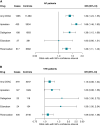In atrial fibrillation epilepsy risk differs between oral anticoagulants: active comparator, nested case-control study
- PMID: 37013704
- PMCID: PMC10228540
- DOI: 10.1093/europace/euad087
In atrial fibrillation epilepsy risk differs between oral anticoagulants: active comparator, nested case-control study
Abstract
Aims: Atrial fibrillation (AF) is a risk factor for brain infarction, which can lead to epilepsy. We aimed to investigate whether treatment of AF with direct oral anticoagulants (DOACs) affects the risk of epilepsy in comparison to treatment with the vitamin K antagonist phenprocoumon (PPC).
Methods and results: We performed an active comparator, nested case-control study based on the German Pharmacoepidemiological Research Database that includes claims data from statutory health insurance providers of about 25 million persons since 2004. In 2011-17, 227 707 AF patients initiated treatment with a DOAC or PPC, of which 1828 cases developed epilepsy on current treatment with an oral anticoagulant. They were matched to 19 084 controls without epilepsy. Patients with DOAC treatment for AF had an overall higher risk of epilepsy with an odds ratio of 1.39, 95% CI (1.24; 1.55) compared to current PPC treatment. Cases had higher baseline CHA2DS2-VASc scores and more frequently a history of stroke than controls. After excluding patients with ischaemic stroke prior to the diagnosis of epilepsy, the risk of epilepsy was still higher on DOACs than on PPC. In contrast, within a cohort of patients with venous thromboembolism, the risk of epilepsy on treatment with DOACs was less elevated [adjusted odds ratio 1.15, 95% CI (0.98; 1.34)].
Conclusion: In patients with AF initiating oral anticoagulation, treatment with a DOAC was associated with an increased risk of epilepsy compared to the vitamin K antagonist PPC. Covert brain infarction may explain the observed elevated risk of epilepsy.
Keywords: Anticoagulation; Atrial fibrillation; Direct oral anticoagulants; Epilepsy; Silent stroke; Vitamin K antagonist.
© The Author(s) 2023. Published by Oxford University Press on behalf of the European Society of Cardiology.
Conflict of interest statement
Conflict of interest: The funder of the study, Federal Joint Committee in Germany, had no influence on the design and conduct of the study, the interpretation of the data, or the decision to publish. K.P., R.F., A.V., I.P., and T.S. are working at an independent, non-profit research institute, the Leibniz Institute for Prevention Research and Epidemiology—BIPS. Unrelated to this study, BIPS occasionally conducts studies financed by the pharmaceutical industry. Almost exclusively, these are post-authorization safety studies requested by health authorities. The design and conduct of these studies as well as the interpretation and publication are not influenced by the pharmaceutical industry. No financial relationships with any organizations that might have an interest in the submitted work in the previous three years; No other relationships or activities that could appear to have influenced the submitted work.
Figures



References
-
- Meinel TR, Kaesmacher J, Roten L, Fischer U. Covert brain infarction: towards precision medicine in research, diagnosis, and therapy for a silent pandemic. Stroke 2020;51:2597–606. - PubMed
-
- Kempster PA, Gerraty RP, Gates PC. Asymptomatic cerebral infarction in patients with chronic atrial fibrillation. Stroke 1988;19:955–7. - PubMed
-
- Maxwell H, Hanby M, Parkes LM, Gibson LM, Coutinho C, Emsley HCA. Prevalence and subtypes of radiological cerebrovascular disease in late-onset isolated seizures and epilepsy. Clin Neurol Neurosurg 2013;115:591–6. - PubMed
MeSH terms
Substances
Grants and funding
LinkOut - more resources
Full Text Sources
Medical

